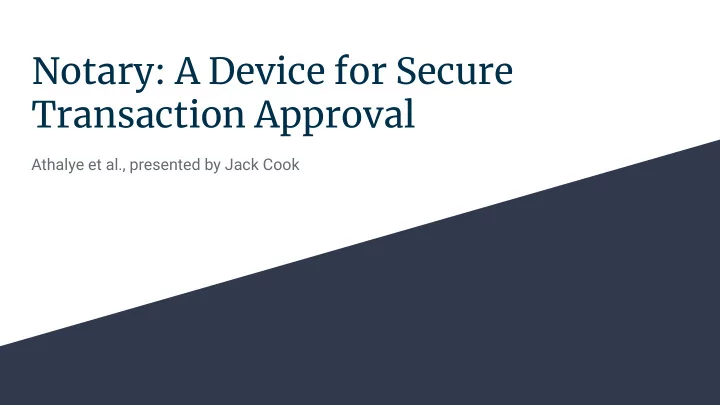

Notary: A Device for Secure Transaction Approval Athalye et al., presented by Jack Cook
Overview Goals and Big Ideas ● Threat Model ● ● Strengths ● Weaknesses Evaluation ● Attack Defenses ● ● Discussion Questions
Notary’s Goals Verify a wide variety of secure transactions, such as BTC transactions, DNS ● updates, and more ● Provide secure task switching between multiple agents running on a single device ● Defend against security vulnerabilities that have plagued multiple existing hardware wallets
Existing Solutions Mobile apps (e.g. Bitcoin wallets, 2FA apps) are susceptible to process isolation ● issues, and smartphones have had bugs that can give adversaries root access ● Hardware wallets (e.g. Ledger, KeepKey, Trezor) have had OS bugs and exploitable side channels System call vulnerabilities, memory protection errors, USB software bugs ○
Big Ideas Separating applications and the kernel into three components significantly ● reduces the attack surface ● Reset-based switching clears the device’s microarchitectural state before executing code from a new agent A “trustworthy I/O path” between agent code and the user prevents adversarial ● tampering ● Deterministic start ensures that agents can’t interfere with each other
Threat Model Notary defends against ● adversaries that want to approve an operation against the wishes of the device’s owner It employs multiple defenses in ● order to do this, in a way that goes beyond existing hardware wallets
Strengths Notary solves a very real problem: the paper listed several motivations for wanting ● to verify important transactions ● Reset-based task switching is a simple but powerful concept, and allows multiple agents to be used on the same device Robust threat model: tainted kernel, malicious agents -- thwarted by, among other ● things, very strong isolation between processes
Weaknesses The “trustworthy I/O path” is susceptible to abuse, and weakens the practicality of ● the device ○ What happens if reviewers make an honest mistake? ○ What happens if the company reviewing new agents goes under? The paper uses LOC as a proxy for complexity, which can be misleading ●
Evaluation Notary has robust defenses against issues that have affected other hardware ● security wallets ● Notary has a verifiable deterministic start, which ensures security ● New agents are easy to develop for Notary Reset-based agent switching is fast and practical ● ● Notary is only slightly more expensive to produce than existing hardware wallets
Poll What types of attacks does Notary’s design defend against? ● ○ Rowhammer ○ Power side channels ○ Microarchitectural side channels Kernel vulnerabilities ○ ○ USB software bugs ○ All of the above
Poll What types of attacks does Notary’s design defend against? ● ○ Rowhammer ○ Power side channels ○ Microarchitectural side channels Kernel vulnerabilities ○ ○ USB software bugs ○ All of the above
Physical Domain Putting USB communication in its ● own domain blunts potential effects Separation of USB software bugs ● Keeping the kernel in a separate domain also protects agents from kernel vulnerabilities ● Having multiple SoCs additionally defends against Rowhammer-type attacks
Non-microarchitectural “Similarly, except for microarchitectural side channels, Notary’s threat model does side channels not include arbitrary side channels [76] such as electromagnetic radiation [12], power analysis [44], and acoustic analysis [30].
Reset-based Task To defend against microarchitectural ● side channels, Notary employed Switching reset-based task switching ● While switching between separate agents, the microarchitectural state is reset to a deterministic default state
Reset-based Task Switching Goal: Completely clear internal state before executing code from a new agent ● ● Reset pin doesn’t guarantee complete reset — registers may be left untouched ● Power cycling can leave state in SRAM for minutes, which can be exploited through cold boot attacks
Reset-based Task Switching Solution: Use a software-assisted ● deterministic start ○ Code runs on CPU as the system resets Clears all architectural state, ○ microarchitectural state, RAM state, and peripheral state
Discussion Questions (Security) Is it acceptable to list power channels outside of the threat model? If my wallet is ● plugged into an arbitrary malicious usb port, is that port supplying power, which can then be monitored? ● Is there anything a malicious agent binary can do? Denial of service? Spoof being another program and confuse the user? ● Are replay attacks possible with the untrusted USB interface?
Discussion Questions (Practicality) How complicated does the agent CPU need to be? To simplify reasoning about the ● reset process, could we just use a simpler CPU rather than a RISC-V chip (such as an ATMega device)? ● Do the limits on agent storage/IO affect the expressiveness of potential agent code? For instance, are there any agents currently deployed on other HW key platforms which cannot be ported to Notary? ● Could you have hardware that ships with this style of wallet already built-in?
Discussion Questions (Agents) How does the kernel know when to switch applications? ● ● Can agents have any internal storage? How would they access and update it? ● Is there any good way to validate during registration that a public key is coming from a correct agent and not a malicious one, in a way securing the registration process as well -- possibly with a root-of-trust signature from the manufacturer?
Recommend
More recommend